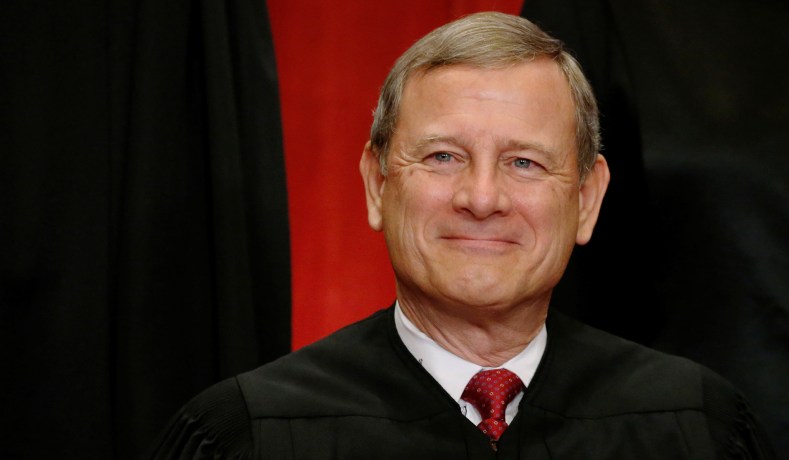

John Roberts and company can restore the original meaning of the First Amendment.
Editor’s Note: The following is the fifth in a series of articles in which Mr. Yoo and Mr. Phillips will lay out a course of constitutional restoration, pointing out areas where the Supreme Court has driven the Constitution off its rails and the ways the current Court can put it back on track. The first entry is available here, the second here, the third here, and the fourth here.
In the wake of the confirmation of Justice Brett Kavanaugh to the Supreme Court, religion will probably present the first test of the new Roberts Court’s commitment to the original meaning of the Bill of Rights. Religion has not become a constitutional battlefield just because conservatives tend to be more religious than liberals (though they are). Religion has not assumed legal importance solely because of the ongoing cultural conflict between traditional and secular visions of our society, either. Religion has taken center stage also because it has become the spiritual and moral refuge from an ever-expanding administrative state.
That state seeks to impose a soulless uniformity on America’s true diversity — of religions and private institutions — in its quest to mimic European welfare states. Elected politicians either have supported the effort or have found it easy to stand by and avoid accountability while the administrative state continues to advance bureaucratic visions of universal health care, welfare programs, or state-run education. Conservatives have had to retreat to the Constitution and the courts to defend the place of conscience in public life.
Their source of support comes from an astonishingly brief text. The First Amendment begins: “Congress shall make no law respecting an establishment of religion, or prohibiting the free exercise thereof.” With these few words, the Founders sought both to protect the freedom to practice religion and to keep the state from interfering with faith in a nation peopled by religious dissenters: the Puritans who settled Massachusetts, the Quakers of Pennsylvania, the Catholics of Maryland, and the Baptists of Virginia. Both the free-exercise and establishment clauses, as they are now known, allowed the great diversity of religions in America to take root and flourish, even as they have died a slow death in Old Europe and much of New Asia.
Even though the main commands of the religion clauses may seem clear, the Supreme Court has distorted them for over a century. While the Roberts Court has done better than previous courts, it has yet to fully embrace their full, original meanings. In last term’s Masterpiece Cakeshop v. Colorado Civil Rights Commission, for example, a baker refused to create a wedding cake for a gay-marriage ceremony. He justified his violation of state antidiscrimination law on the ground that it forced him to compromise his religious beliefs. Rather than take a stand on behalf of the baker’s right of free speech and free exercise of religion, the Court — in an opinion written by Justice Anthony Kennedy — instead found that an obscure Colorado state antidiscrimination agency had exhibited hostility toward the baker’s faith during a public hearing. The Court’s opinion could be read to mean that states can violate the right to freedom of religion in the future, so long as they play nice in public.
Or take the nuns of the Little Sisters of the Poor, a Catholic religious order that operates homes for the elderly poor. Obeying Catholic teaching, the Order refused to provide contraceptives in its health-insurance policies, in violation of the Obama administration’s demands under the Affordable Care Act. In 2016, the Roberts Court refused to reach the obvious judgment that the Obama mandate violated the federal Religious Freedom Restoration Act of 1993 (which requires the government to have a compelling interest to impose such a burden on religious groups and to do so in the most narrowly tailored way), or the First Amendment itself. Instead, it remanded the cases because the Obama administration promised that insurers themselves would bear the costs of contraceptive coverage — demonstrating once again the Obama administration’s, if not the Court’s, failure to understand simple economics. The Court’s evasion puzzles even more because, in the 2014 Hobby Lobby case, it had held in an opinion by Justice Samuel Alito that the Obamacare mandate violated the statutory religious rights of a private corporation.
The new Roberts Court can begin to bring order to its protection of religion by flatly overturning two decisions: Lemon v. Kurtzman on the establishment clause and Employment Division v. Smith on the free-exercise clause. Justice Kavanaugh’s confirmation may now give conservatives enough of a Court majority to restore the First Amendment’s original meaning. It could do so with the support of Congress, which in 1993 sought to overrule Smith with the Religious Freedom Restoration Act, which passed the House or Representatives by unanimous voice vote, the Senate by 97–3, and was signed into law by President Bill Clinton.
It could also bring intellectual harmony to two clauses that the courts have often interpreted as being in conflict. For instance, the establishment clause has been read to prohibit government from doing anything that advances religion. Yet the free-exercise clause actually advances religion by accommodating religious practices that may be in conflict with otherwise acceptable law. Likewise, some have interpreted the establishment clause to prohibit any government funding flowing to a religious organization. But discriminating against religious entities just because of their faith, and giving them second-class status compared with secular entities, has been found to violate the free-exercise clause. In short, to the extent the establishment clause is viewed as hostile to religion and the free-exercise clause as solicitous of religion, the First Amendment is at war with itself. And that makes little sense historically or logically.
Rather than create a paradox, the religion clauses complement each other in supporting religious freedom. The Founders knew both from history and from their own experience that the government could harm religion not only by direct acts of suppression, but also indirectly by favoring some over others or by interfering in churches’ internal affairs. The Founders designed the First Amendment’s two religion clauses to protect religious pluralism without banishing religion from the public square.
Yet the Supreme Court has long missed the message. In the much-maligned three-part Lemon test, the Court finds a violation of the establishment clause if a government act lacks a secular purpose, advances or inhibits religion, or fosters excessive government entanglement with religion. For decades, the federal judiciary has used the Lemon test not just to strike down government financial aid to religious groups, but even to ban prayers at ceremonies and symbolic religious displays at Christmas time and other holidays.
The Court has somewhat distanced itself from the test in recent years, invoking it less and less often. To its credit, the Rehnquist Court took tentative steps to allow religious groups to participate in public programs, such as providing education or administering welfare programs, on an equal footing with secular groups. But the Court has yet to officially finish Lemon off. Several liberal justices still seem to favor its aggressive effort to expunge religion from public life. As Justice Scalia once observed, Lemon is “like some ghoul in a late-night horror movie that repeatedly sits up in its grave and shuffles abroad, after being repeatedly killed and buried.”
This reticence to kill and bury Lemon for good creates two problems. First, lower courts are still bound to follow Lemon until the Court overturns it. Lemon’s three-part test allows for plenty of mischief for lower courts and anti-religion activists; they can manipulate the balancing test to find virtually any mention of religion — even “under God” in the Pledge of Allegiance, as one Court of Appeals notoriously decided — unconstitutional.
Second, the Court’s on-again, off-again attitude toward Lemon balkanizes the establishment clause, leading to varying judicial tests that fail to provide uniform protection to religion throughout the nation. For example, Justice Kennedy liked to invoke a “coercion” test, which asked whether the government had forced dissenters into participating in a religious exercise. In Lee v. Weisman (1992), Kennedy and Justice Sandra Day O’Connor joined the liberal justices to find unconstitutional a nondenominational prayer at the graduation ceremony of a public high school. Justice O’Connor even preferred an “endorsement” test, wherein the question is whether a reasonable observer would understand the government action as endorsing religion and making some feel like outsiders. But such rules just allow a judge to import his own views as to what a “reasonable observer” would think and feel.
While the Court has become too aggressive in its scrutiny of religion in the public square, it has simultaneously proven passive in protecting the rights of religious minorities. For example, in the 1990 case Smith v. Employment Division, the Court held that claims of religious freedom must give way before neutral and generally applicable laws. Followers of a Native American religion, therefore, had no right to smoke hallucinogenic drugs in violation of the anti-drug laws. Smith turned constitutional religious liberty into a shell of its former self, because it forces religious groups to depend on legislators alone, rather than the Constitution, for the exemptions of conscience that had regularly appeared in American law.
The sad irony of Smith was that its author, Justice Scalia, failed to engage with the original meaning of the free-exercise clause. While normally persuaded by historical arguments, Scalia instead worried about cabining judicial discretion. With a denuded constitutional right to religious freedom, the religious have turned to statutory remedies, or characterizing the government practice as targeting religion. This has left a gaping hole in the First Amendment, one that the Court can now fill.
So what should the Court do? It should return to the original meaning of the religion clauses — to the view held by those who wrote and ratified the Bill of Rights. As research by Michael McConnell has shown, an “establishment” of religion had historical meaning and was manifested in government practices of coercing individuals in the area of religion, interfering with church autonomy, proclaiming a state church, or improperly financially supporting a particular faith.
But outside these historical examples, the Constitution is not offended. Early Congresses, for example, selected two official chaplains (of different denominations) and passed the Northwest Ordinance with its language that religion was “necessary to good government and the happiness of mankind.”
While president, Thomas Jefferson found no problem with attending worship services held by different denominations on Sundays in the House of Representatives, nor with authorizing the Marine Band to take part in those services. Likewise, President Jefferson opened up the building of the War Office and the Treasury for use by all denominations for Sunday services. Even the Supreme Court was used for church services on Sundays at this time, leading to the observation that “on Sundays in Washington during Thomas Jefferson’s presidency, the state became the church.”
A historical test will restore the clause to its rightful role: fostering religion generally, so long as government does not favor any particular sect or invade a faith’s internal domain. The Roberts Court has slowly moved in this direction. In a recent case, Town of Greece v. Galloway, the Court suggested that a test rooted in the original meaning of the religion clauses should be the test for the Court, regardless of the context. With the Court’s recently granted case on a cross in a Maryland park, the Court can once and for all dispose of Lemon and return to an establishment-clause jurisprudence that supports the free exercise of religion rather than undermining it.
As for the free-exercise clause itself, in place of Smith, the Court should return to the understanding of the clause in 1791. Those who drafted and ratified the Bill of Rights would have understood the right to free exercise of religion to protect religious practice, not just belief. They would have understood it to safeguard not just worship at church or religious practice in the home or in church, but also in public.
Of course, religious freedom — like any other individual right — does not exist unfettered. At the time of the Founding, the free exercise of religion was understood to be a natural right. According to John Locke, natural rights are limited by the law of nature, meaning they could not be exercised to injure the equal rights of others. James Madison, who authored the first draft of both the Constitution and the Bill of Rights, argued that the free exercise of religion must respect others’ private rights as well as the public peace. Free-exercise clauses in Founding-era state constitutions incorporated various exceptions to the right, such as practices “repugnant to the peace and safety of the State” or that injure others’ “natural, civil, or religious rights.” Only the strongest interests of the state or the rights of others could overcome the “unalienable right” of religious freedom.
These materials suggest that Smith incorrectly removed the privileged place of religious freedom. Contrary to the Court’s interpretation, the Constitution requires that most religious dissenters receive an exception to even neutral and generally applicable laws.
An approach rooted in history would flip the burden in the courts by requiring the state to show that a religious practice harms others or public safety, rather than today’s regime, which requires religious minorities to prove they deserve an exception because laws that appear neutral are actually targeting religious practices. Or, at the very least, the Roberts Court could overrule Smith and return to the free-exercise cases of the past, which held that government could infringe religious freedom only if it had a compelling interest and achieved that interest in the least restrictive possible way.
All of this still leaves room for legislative compromises when rights clash. Thus, laws can still recognize other rights while accommodating religious freedom in an attempt to provide dignity, fairness, and freedom for all. Surely legislatures, not courts, are much better suited to compromise. And compromise is needed in this age of identity, since religious identity is just as important as race, gender, sexual orientation, or other fundamental identities.
A proper understanding of the religion clauses will have at least two more important benefits. First, religion will be free to provide the societal benefits that have long flowed from it but have been curtailed in the past half-century or so. Religious individuals and institutions have historically delivered education, provided welfare services, and strengthened the moral order much more effectively (and much more cheaply) than government has. As George Washington presciently observed in his farewell address, “let us with caution indulge the supposition, that morality can be maintained without religion . . . reason and experience both forbid us to expect that National morality can prevail in exclusion of religious principle.” Religion can play a robust role in helping society without running afoul of the establishment clause.
Second, a proper understanding of the religion clauses will diffuse the tension between a Court that has often viewed religion with European skepticism and a public that is still largely religious. For instance, while faith has mostly faded in Western Europe, leaving beautiful but empty cathedrals and chapels, Americans still believe and participate in religion at comparatively high rates. Hence, according to a recent Pew survey, over 78 percent of Americans claim a religion, 83 percent are absolutely or fairly certain that God exists, 77 percent deem religion very or somewhat important in their lives, 69 percent attend religious services, and 71 percent pray at least weekly.
Religion has long had a special place in the United States. The Constitution’s First Amendment singles it out for special protection. But the Court has strayed from the Constitution’s commands. By restoring the original meaning of the religion clauses, the Roberts Court can return religious freedom to its constitutionally privileged place in our republic.
— John Yoo is the Emanuel S. Heller Professor of Law at the University of California, Berkeley, a visiting scholar at the American Enterprise Institute, and a visiting fellow at the Hoover Institution at Stanford University. James C. Phillips is an attorney in private practice and a non-resident fellow at Stanford Law School’s Constitutional Law Center.



